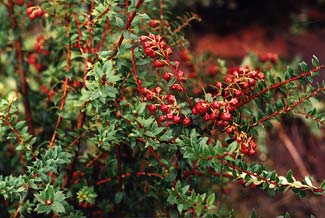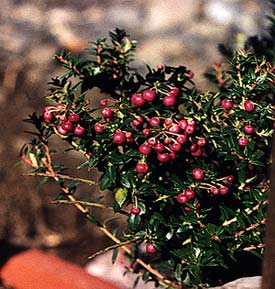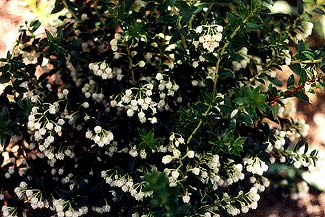 Pernettya mucronata's year-round ornamental berries
Pernettya mucronata's year-round ornamental berries
Pernettya mucronata's common name "Prickly Heath" suggests it might be thorny, but it is not. The leaves are merely sharply pointed & capable of poking a bit, but I still don't see it as a good name. Others must agree, for most people just call it Pernettya & forget its old common name.
It is a broadleaf evergreen shrub with leaves that are glossy green most of the year, occasionally bronzy in winter. It bears small white to pink bell-shaped flowers in May & June. The fruits vary in color depending on the cultivar, & these fruits are the main reason this shrub is an outstanding beauty.
There are varieties with pink berries, white berries, lilac berries, & the brightest conceivable glistening red berries. These develop in summer following the blooming period & they persist through autumn & winter & long into the following spring without any sign of wearing out! When it blooms in May, it still has a good load of the previous year's red berries on all the branches. The previous year's berries in fact begin to grow larger after having remained small & shiny & fresh through the winter. On the topic of the edibility of these berries, do also read my article Are Pernettya Berries Edible or Poisonous? That page has additional photos, showing the shrubs in bloom.
 We have multiple Pernettyas because I just fell in love with it & wanted at least one of every variety I could find. I still lack one with lilac berries, but soon as I spot one, it's mine. The photo at the top of the page is of P. m. "Rubra" which is the one with the most startlingly red glistening berries, & which seems to be the most popularly offered variety in the Northwest. The photo was taken in February, but the berries look like this year round. The second photo, taken in March, is of a pruned branch of P. m. "Pink" peaking around the corner of the garage & over the edge of a potted wisteria. It has a paler berry than the Rubra, & does not have such red twigs as the Rubra.
We have multiple Pernettyas because I just fell in love with it & wanted at least one of every variety I could find. I still lack one with lilac berries, but soon as I spot one, it's mine. The photo at the top of the page is of P. m. "Rubra" which is the one with the most startlingly red glistening berries, & which seems to be the most popularly offered variety in the Northwest. The photo was taken in February, but the berries look like this year round. The second photo, taken in March, is of a pruned branch of P. m. "Pink" peaking around the corner of the garage & over the edge of a potted wisteria. It has a paler berry than the Rubra, & does not have such red twigs as the Rubra. We also have one male Pernettya, shown below in full bloom in May. Males aren't supposed to have berries, but some males have a weak androgynous capacity, & our stunty little boy last year (2001) set a few large white berries on the lower part of his branches; a white-berrying male, I've been told but haven't seen an authoritive statement, is sold as "Thymifolia" so perhaps that is what our boy is, though when we bought it, it was only labeled "Male." Another male, sold as "Bells Seedling," will definitely produce a few red berries.
Female Pernettyas will have quite thrilling berries even if you don't have a male to help, & it can be a little hard to find males for sale, since nurseries find them less easily sold for lacking the bright berries. But if you can find at least one male for a grouping, the many berries the females produce will be larger.
 This shrub grows to five feet height but can become rangy if not hedged to about three feet. I'm trying to let ours grow a little rampant if they will, but if the conventional wisdom "need's its top branches trimmed to remain attractive" turns out to be true, I may eventually end up clipping them. So far, "letting them go" has made them look a bit wild, but not rangy, & I can't complain.
This shrub grows to five feet height but can become rangy if not hedged to about three feet. I'm trying to let ours grow a little rampant if they will, but if the conventional wisdom "need's its top branches trimmed to remain attractive" turns out to be true, I may eventually end up clipping them. So far, "letting them go" has made them look a bit wild, but not rangy, & I can't complain. Pernettya prefers sun to part shade, loamy acidic soil, & has a higher than average water need so can even tolerate swampy conditions, yet once established will not suffer too much from occasional short periods of droubt. It is hardy in a wide temperature range & is not subject to wind-burn, so can be in quite exposed areas & do well. So it's not surprising to find it in so many different environments throughout the southern hemisphere, from Mexico to Chile to Argentina to near the Antarctic to New Zealand & Tasmania.
In conditions it likes best it can become invasive & may need it's underground runners chopped through with a shovel from time to time to keep it from going places you don't want it. Ours is confined between the alley & the garage tarmack, so is not likely to ever be a problem.